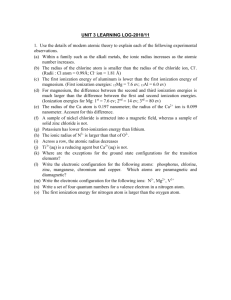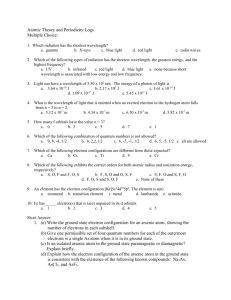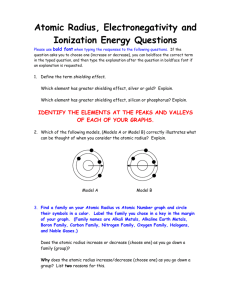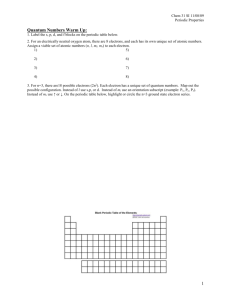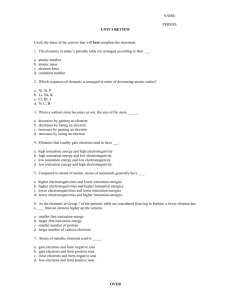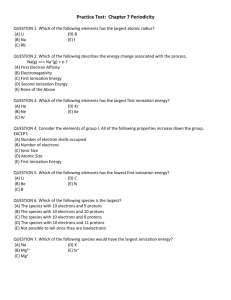Purpose : Given Lecture , Data , Procedure
advertisement
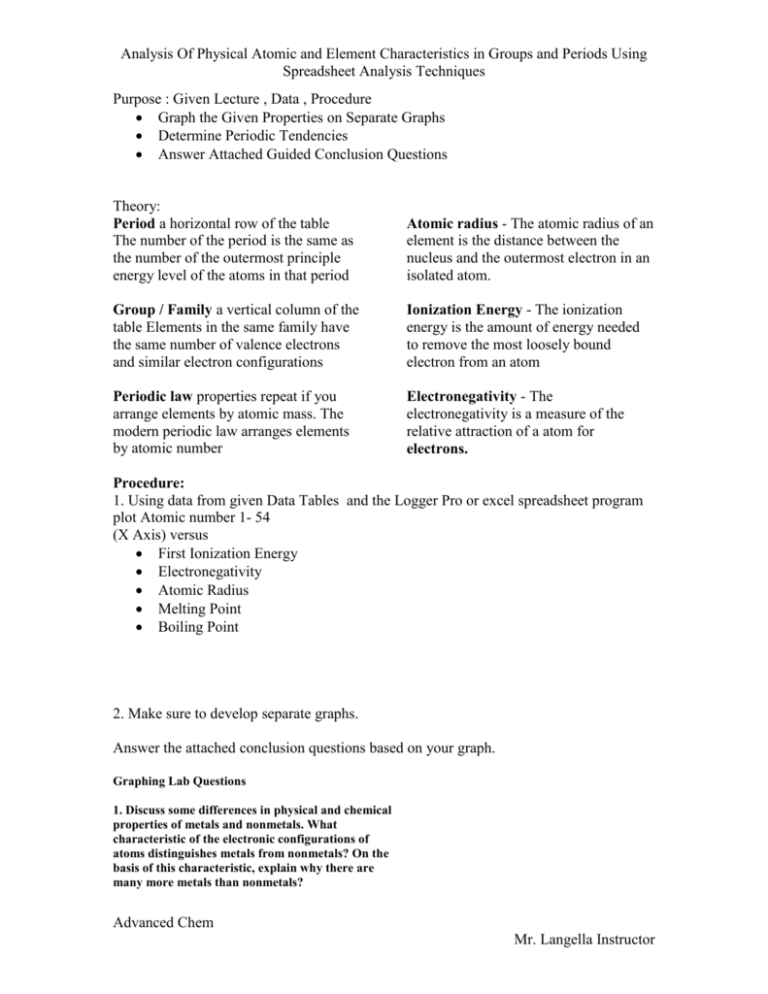
Analysis Of Physical Atomic and Element Characteristics in Groups and Periods Using Spreadsheet Analysis Techniques Purpose : Given Lecture , Data , Procedure Graph the Given Properties on Separate Graphs Determine Periodic Tendencies Answer Attached Guided Conclusion Questions Theory: Period a horizontal row of the table The number of the period is the same as the number of the outermost principle energy level of the atoms in that period Atomic radius - The atomic radius of an element is the distance between the nucleus and the outermost electron in an isolated atom. Group / Family a vertical column of the table Elements in the same family have the same number of valence electrons and similar electron configurations Ionization Energy - The ionization energy is the amount of energy needed to remove the most loosely bound electron from an atom Periodic law properties repeat if you arrange elements by atomic mass. The modern periodic law arranges elements by atomic number Electronegativity - The electronegativity is a measure of the relative attraction of a atom for electrons. Procedure: 1. Using data from given Data Tables and the Logger Pro or excel spreadsheet program plot Atomic number 1- 54 (X Axis) versus First Ionization Energy Electronegativity Atomic Radius Melting Point Boiling Point 2. Make sure to develop separate graphs. Answer the attached conclusion questions based on your graph. Graphing Lab Questions 1. Discuss some differences in physical and chemical properties of metals and nonmetals. What characteristic of the electronic configurations of atoms distinguishes metals from nonmetals? On the basis of this characteristic, explain why there are many more metals than nonmetals? Advanced Chem Mr. Langella Instructor Analysis Of Physical Atomic and Element Characteristics in Groups and Periods Using Spreadsheet Analysis Techniques 2. Use the details of modern atomic theory to explain each of the following experimental observations. (a) Within a family such as the alkali metals, the ionic radius increases as the atomic number increases. (b) The radius of the chlorine atom is smaller than the radius of the chloride ion, Cl-. (Radii : Cl atom = 0.99Å; Cl- ion = 1.81Å) (c) The first ionization energy of aluminum is lower than the first ionization energy of magnesium. (First ionization energies: 12Mg = 7.6 ev; 13Al = 6.0 ev) (d) For magnesium, the difference between the second and third ionization energies is much larger than the difference between the first and second ionization energies. (Ionization energies for Mg: 1st = 7.6 ev; 2nd = 14 ev; 3rd = 80 ev) 3. Based on your graph, The diagram shows the first ionization energies for the elements from Li to Ne. Briefly (in one to three sentences) explain each of the following in terms of atomic structure. (a) In general, there is an increase in the first ionization energy from Li to Ne. (b) The first ionization energy of B is lower than that of Be. (c) The first ionization energy of O is lower than that of N. (d) Predict how the first ionization energy of Na compares to those of Li and of Ne. Explain. 4. Account for each of the following in terms of principles of atom structure, including the number, properties, and arrangements of subatomic particles. (a) The second ionization energy of sodium is about three times greater than the second ionization energy of magnesium. (b) The difference between the atomic radii of Na and K is relatively large compared to the difference between the atomic radii of Rb and Cs. (c) A sample of nickel chloride is attracted into a magnetic field, whereas a sample of solid zinc chloride is not. 5. Use principles of atomic structure to answer each of the following. (a) The radius of the Ca atom is 0.197 nanometer; the radius of the Ca2+ ion is 0.099 nanometer. Account for this difference. (b) Explain the difference between Ca and K in regard to (i) their first ionization energies, (ii) their second ionization energies. (c) The first ionization energy of Mg is 738 kilojoules per mole and that of Al is 578 kilojoules per mole. Account for this difference. Advanced Chem Mr. Langella Instructor Analysis Of Physical Atomic and Element Characteristics in Groups and Periods Using Spreadsheet Analysis Techniques 6. Explain each of the following observations using principles of atomic structure and/or bonding. (a) Potassium has a lower first-ionization energy than lithium. (b) The ionic radius of N3– is larger than that of O2–. (c) A calcium atom is larger than a zinc atom. (d) Boron has a lower first-ionization energy than beryllium. Advanced Chem Mr. Langella Instructor
